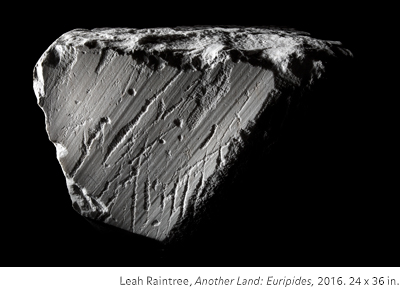Another Land: After Noguchi by MFA Alum Leah Raintree Opens at the Noguchi Museum
Wednesday, August 10, 2016 – Sunday, January 8, 2017
Another Land: After Noguchi, an exhibition of photographs by Leah Raintree, extends the more than century-old tradition of astrophotography to consider the microcosms inherent in the sculptures of Isamu Noguchi.
In the summer of 2015, Raintree embarked on a project at neighboring Socrates Sculpture Park that joined two sources of inspiration: her studies of Noguchi’s mark-making on stone and a recent mission by the European Space Agency’s Rosetta space probe, which streamed images of Comet 67P back to Earth while landing a smaller craft on its surface. With the enigmatic photographs taken by Rosetta during its approach to 67P in mind, she reimagined a small granite stone that she sculpted and then photographed as a distant asteroid. Shortly thereafter Raintree began a similar photographic investigation of The Noguchi Museum collection.
Raintree’s work frames the relationship between human activity and its environmental impacts through process, as functions of material and scale. She engages mark-making through drawing, performative interactions with matter, and documentation of found marks within phenomena. Her interest lies in expanded time frames, often embedding distinctly human marks within ambient accumulations that mimic geology. She found a kindred spirit, and an abundance of information, in Noguchi, whose postwar stone sculptures seize on qualities inherent to quarried rock, amplifying fractures and breakages to reveal the geological passage of time—and, correspondingly, set up an extended metaphor for the limited nature of human existence.
Raintree initially focused on Noguchi’s landscape table sculptures. These planes of stone preserve the neatness of the quarry’s processing cuts and effectively become “shaved” material samples extracted from Earth’s geological deposits. Noguchi punctuated them with elevated mounds and plateaus, juxtaposing stippled areas with various degrees of polish, suggesting a muting and a loss of surface detail seen from a great distance. From this starting point, Raintree’s sessions photographing in the galleries expanded to encompass works in stone in all its variations, and further still to Noguchi’s hand-formed ceramics, project models, sets, and Akari light sculptures.
Noguchi occasionally engaged professional photographers to visualize the physical space of his early model proposals for landscapes, garden spaces, and the occasional monument, and their completed counterparts. Photography’s necessarily creative fictionalization of sculpture was a tool he used to process his widescreen vision for these projects, and it likewise made its way back into his studio practice. One notable instance, the sole surviving photo artifact of a conceptual model for a proto-earthwork called Sculpture to Be Seen From Mars (1947), a monumental epitaph to Earth’s inhabitants in the form of an abstracted human visage, seems to have planted the seed for Noguchi’s later work with the landscape tables.
With documentary photography already a constant in terms of the presentation and conceptual framing of Noguchi’s work, Raintree’s photographs propose yet another vantage for looking at his sculptures—one that engages the surfaces and material character of his work to recast them in a fictive light as celestial objects. Within his lifetime, Noguchi witnessed the dramatic evolution of astrophotography. Through attentive lighting and framing and an allusive nod towards science fiction (e.g. 2001: A Space Odyssey), Raintree recasts Noguchi’s surfaces as forbidding, barren, depleted, or otherwise uncharted landscapes—a fitting association given Noguchi’s interest in the ecology of our planet and the exploration of others. Raintree’s photographs also support more dystopian interpretations, such as the slate-cleaning return to nothing that may follow a man-made apocalypse. But most importantly, in distilling Noguchi’s hand through visual dislocation and shifts in scale, they turn the sculptures into self-evident formations, thus extending the reach of each stone into the galactic timescale.
The exhibition is accompanied by an illustrated publication with an introduction by Noguchi Museum Director Jenny Dixon and texts by Senior Curator Dakin Hart and Jay Bernstein, Distinguished Professor of Philosophy, New School for Social Research, as well as an interview with the artist by Noguchi Museum Associate Curator Matt Kirsch.
Public Tour Dates:
Sunday, September 25, 2016 – 2:00pm – 3:00pm
Saturday, October 29, 2016 – 2:00pm – 3:00pm
Sunday, December 4, 2016 – 2:00pm – 3:00pm
The Noguchi Museum is located at 9-01 33rd Road (at Vernon Boulevard), Long Island City, NY
PRESS
The exhibition has received excellent press during its first month, with a nice selection of coverage included below.
NYAQ / LXAQ / SFAQ: International Art and Culture: Review by Ella Coon
The Creators Project: Interview with Andrew Nunes
The Wall Street Journal: Review by William Meyers

